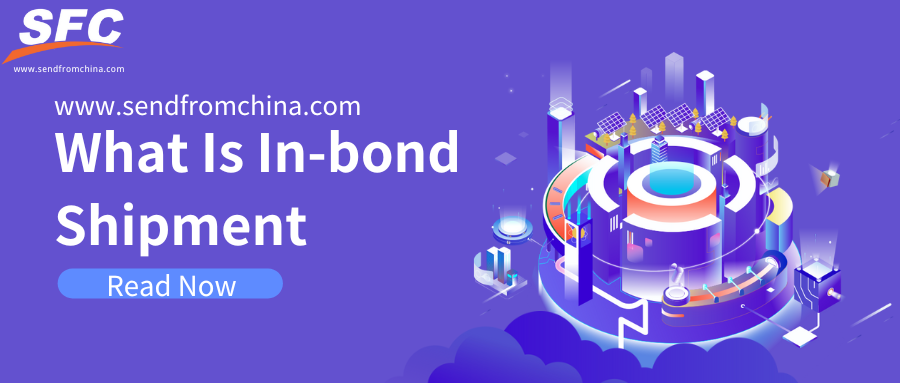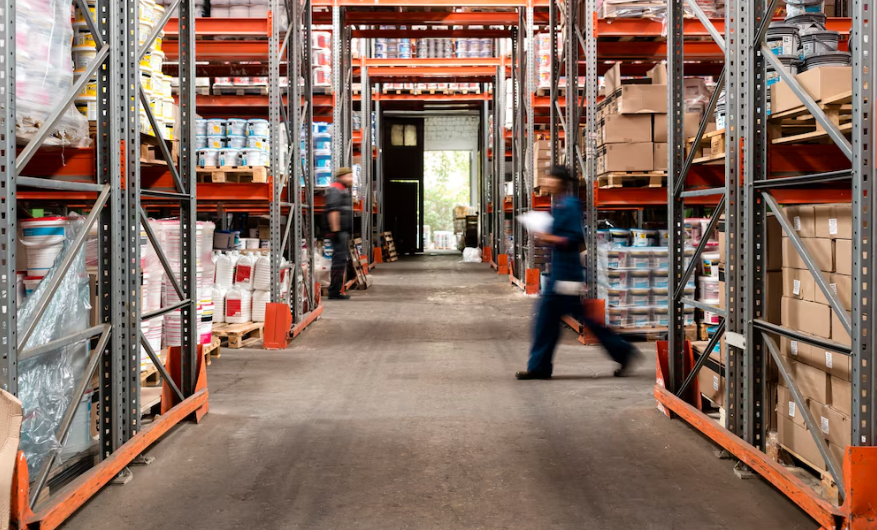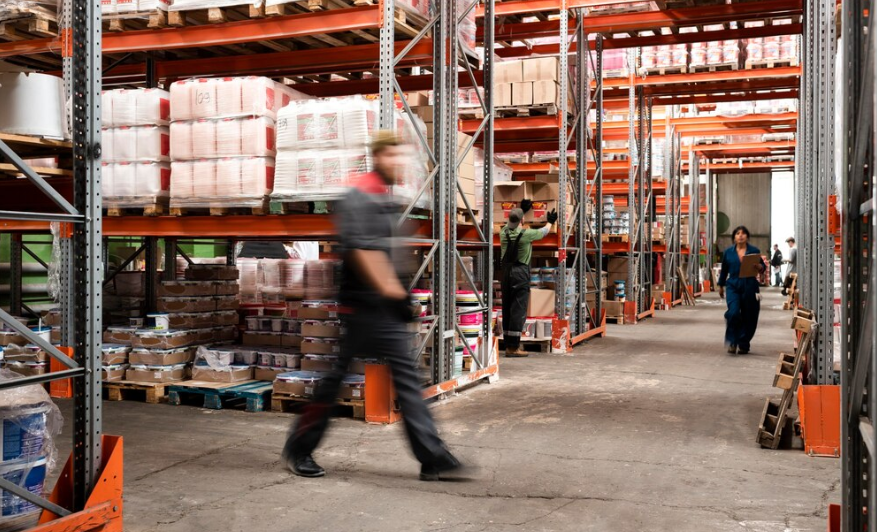Table of Contents
In-Bond Shipment Explained: What It Is, How It Works & Why It Matters
Time: Aug 23,2025 Author: SFC Source: www.sendfromchina.com
In international logistics, in-bond shipments serve as the silent workhorse behind efficient cargo movement—letting goods travel under customs supervision without immediate clearance or duty. Whether you're navigating shipments from China or coordinating multi-point transit, understanding how to ship in-bond is essential for streamlining customs, optimizing cash flow, and maintaining flexible inventory control.
1. What Is In-bond Shipment
At its core, an in-bond shipment refers to goods that enter a destination country—or move within it—without undergoing immediate customs clearance or duty payment. Instead, these items remain under customs supervision, either routed onward to another destination or held in a bonded facility. Customs duties and taxes are deferred until final importation or release—creating flexibility in both cash flow and logistics.Practically speaking, this could be goods arriving at a U.S. port that don’t immediately clear customs, but instead head to a bonded warehouse or another port. Until they “enter commerce,” duties and taxes stay suspended.
2. Benefits of In-bond Shipment
Navigating the global trade maze? In-bond shipments are often your hidden ace—offering financial breathing room, operational agility, and strategic inventory management. Let’s break down each advantage with clarity and concrete context.
Deferred Duties and Taxes: Better Cash Flow, Smarter Capital Use
One of the most impactful advantages: duties and taxes aren’t due until the goods officially enter commerce or reach their final destination. Businesses, especially those working with tight margins or startup logistics budgets, get to reinvest capital elsewhere until clearance. This kind of delay in payment can be a powerful enabler for agile cash flow management.Streamlined Transit & Reduced Port Congestion
Instead of sitting idly at crowded ports, goods can be swiftly redirected to bonded zones or alternate locations under customs control. This bypass can slash typical port delays and move freight faster through the chain.Reduced Customs Paperwork & Administrative Hassle
When cargo moves in-bond, it's exempt from immediate full customs clearance. That means fewer formalities up front—lighter documentation burden, less red tape, and smoother internal processes.Flexible Consolidation & Deconsolidation of Shipments
In-bond arrangements allow consolidating goods from multiple suppliers into one shipment at a bonded hub. Later, you can deconsolidate near final destinations. The result? Lower shipping and handling costs plus optimized last-mile logistics.Strategic Inventory Placement & Control
Need stock but not today? Store in bonded warehouses where duty payment is delayed. With this flexibility, you align inventory with demand curves, preventing unnecessary carrying costs.Enhanced Security & Reduced Risk
Bonded facilities and carriers operate under strict customs oversight. This provides protection from theft, tampering, or unauthorized diversion. It's less risky and more secure than standard open storage.Smarter Compliance & Trust with Customs
Using in-bond procedures backed by bonds helps build trust with customs agencies. Clear paperwork and financial guarantees position your business as reliable and compliant—sometimes leading to faster inspections or fewer hold-ups.3. Types of In-Bond Shipments
When we talk about in-bond shipping—especially within the U.S.—there are several distinct types, each tailored to meet specific logistical needs. Understanding these categories helps you choose the right path for your cargo.
Immediate Transportation (IT)
IT allows goods to be moved from the port of arrival to another customs location inside the U.S., without paying immediate duties. This is commonly used when the importer prefers to clear goods at a more convenient inland facility or distribution center. Generally, this must be completed within 30 days, and requires both a customs bond and electronic filing.Why it matters: It streamlines logistics and saves time—not all ports are set up for the same clearance workflows, so choosing the right location can reduce delays and handling costs.
Transportation & Exportation (T&E)
Often referred to as “transit in-bond,” T&E enables goods to enter through one U.S. port and exit through another—without ever entering U.S. commerce or incurring duties. It must be transported and exported within about 30 days. The method is especially useful for goods transiting through the U.S. en route to another country.Why it matters: Perfect for manufacturers or distributors wanting to leverage U.S. infrastructure for processing or consolidation before sending goods onward—with zero import tax burden.
Immediate Exportation (IE)
With IE, goods arriving at a U.S. port are immediately exported from the same port, without clearing U.S. customs. The exit must happen within roughly 15 days.Why it matters: Ideal for goods merely passing through as part of global logistics—not for distribution in the U.S.—this keeps handling minimal and the paperwork streamlined.
Bonded Warehouse Entry (WE)
This is where storage meets strategic flexibility. Goods can be entered into a bonded warehouse—a secure state- or privately-managed facility—delaying duty payment until the goods are withdrawn for consumption. Pricing and timelines vary, but in the U.S., bonded warehouse storage can last up to five years.Why it matters: Perfect for businesses that wish to store, repack, or manipulate products before release—or hold stock pending demand—while keeping cash tied up for longer.
Specialized Categories (Vessel & Aircraft Supplies, Warehousing Withdrawals)
Beyond the core IT, T&E, IE, and WE types, U.S. Customs regulation (19 CFR 18.1) also recognizes additional categories, such as:- Warehouse withdrawals for IT or T&E—where goods move from a bonded warehouse either for transportation or exportation.
- Supplies for vessels or aircraft, whether immediately exported or transported and exported under bond.
Why it matters: These accommodate logistics for airline or maritime support—think spare parts or onboard supplies—which don’t require commercial importation but still move under customs oversight.
4. What Are the In-bond Shipment Processes
In-bond shipments demand precision, timing, and effective coordination across customs authorities, carriers, and logistics partners. Below, we break down the steps, common pitfalls, and tips that make this process work.
Step 1: Filing the In-Bond Application
At the outset, the importer or its agent submits an in-bond application electronically to U.S. Customs and Border Protection (CBP), typically via ABI systems like ACE or QP/WP. This digital submission includes essential data such as:- Description of goods and six-digit HTS code
- Origin, point of entry, and ultimate destination
- Bond type (e.g., IT, T&E)
- Container seals and numbers
- Value, quantity, and packaging information
CBP reviews the application. Once approved, they issue a unique in-bond number—your shipment’s digital fingerprint for tracking.
Step 2: Securing the Customs Bond
A customs bond is your financial guarantee that duties, taxes, or penalties will be paid if necessary. Depending on the shipment type, this could be a single-entry bond or a continuous bond (common for frequent importers). In the U.S., the standard continuous bond is often $50,000 and covers multiple shipments annually.Without this bond, in-bond movement simply can’t begin.
Step 3: Preparing Documentation
Alongside your bond and application, several key documents are typically required:- CBP Form 7512 (Transportation Entry and Manifest of Goods)
- Bill of Lading
- Packing List
- Commercial Invoice
If using bonded warehouses, you’ll also need warehouse entry documentation.
Step 4: Transport Under Bond
Once all filings are approved, your goods are ready to move under customs supervision. A bonded carrier—authorized and registered with CBP—transports the shipment to either:- Another customs port (IT/T&E)
- A bonded warehouse (WE)
- Or directly back out of the country (IE)
This movement must adhere strictly to approved routes and timelines. For most shipments, you must complete transit within 30 days, though longer (up to 60 days) may apply for barge transport.
Step 5: Arrival & CBP Acknowledgment
Upon reaching the destination, the bonded carrier or agent electronically “arrives” the shipment in the CBP system (via ACE or QP/WP). This step is critical and must happen promptly—delays can open the door to fines of up to $1,000 per violation, or worse.If shipment plans change during transit, you’ll need to submit a fully authorized diversion request before rerouting.
Step 6: Final Disposition—Clearance, Export, or Storage
Once arrived, the final step depends on the type of in-bond movement:- Clearance into commerce—duties paid, goods released
- Storage in bonded facilities—duty deferred, release when needed
- Re-export—goods exit without ever entering commerce
If stored, goods may remain in bonded warehouses for up to 5 years in the U.S., allowing repacking or consolidation under customs supervision.
5. Challenges of In-bond Shipment
While in-bond shipments offer significant advantages, such as deferred duty payments and streamlined cross-border logistics, they also present a unique set of challenges. Navigating these complexities requires careful planning, adherence to regulations, and effective coordination among all parties involved.
Regulatory Compliance and Documentation
In-bond shipments are governed by stringent customs regulations that vary by country and can change frequently. Ensuring compliance with these regulations is paramount to avoid costly penalties and delays. Common documentation errors include:- Incorrect or incomplete forms: Missing or inaccurate information on required documents can lead to shipment holds or rejections.
- Failure to update regulatory changes: Customs regulations can change, and staying informed about these changes is crucial to maintain compliance.
For instance, in the U.S., the Automated Commercial Environment (ACE) system is used to track in-bond shipments. However, persistent weaknesses in this system have impeded the effective management of in-bond cargo, leading to open transactions and delayed closures.
Complex Logistics and Coordination
Managing in-bond shipments involves coordinating multiple parties, including customs authorities, bonded carriers, and warehouses. Challenges in this area include:- Limited carrier options: Not all carriers are authorized to transport in-bond goods, which can limit shipping options and increase costs.
- Timing constraints: In-bond shipments must adhere to strict timelines, and delays at any point in the process can result in penalties.
- Communication breakdowns: Miscommunication between stakeholders can lead to errors in documentation, routing, and delivery schedules.
For example, moving freight in-bond across the U.S. can be a difficult process to get right, especially without a well-rounded understanding of how this is done.
Customs Inspections and Delays
In-bond shipments are subject to customs inspections, which can vary in intensity and frequency. Challenges include:- Unpredictable inspection schedules: Customs authorities may select in-bond shipments for inspection without prior notice, leading to unexpected delays.
- Extended processing times: Inspections can take time, and any issues identified may require additional documentation or clarification, further delaying the shipment.
These delays can disrupt supply chains and affect inventory management, especially for businesses relying on just-in-time inventory systems.
Financial Risks and Liabilities
While in-bond shipments allow for deferred duty payments, they also carry financial risks:- Liability for duties and taxes: If the goods are not exported or entered into U.S. commerce within the allowed timeframe, the importer may be liable for the payment of duties and taxes.
- Potential penalties: Non-compliance with in-bond regulations can result in significant fines and penalties, impacting the financial health of the business.
For example, the U.S. Customs and Border Protection (CBP) has assessed problems with the in-bond system, including issues with reporting and monitoring, which can lead to financial liabilities for importers.
Infrastructure and Capacity Constraints
The infrastructure supporting in-bond shipments, such as bonded warehouses and transportation networks, may face capacity constraints:- Limited warehouse space: High demand for bonded warehouse space can lead to shortages, affecting the ability to store goods temporarily.
- Transportation bottlenecks: Congestion at ports and along transportation routes can delay the movement of in-bond shipments.
These constraints can disrupt the smooth flow of goods and increase costs associated with storage and transportation.
Evolving Trade Policies and Tariffs
Changes in trade policies and tariffs can impact the viability of in-bond shipments:- Tariff adjustments: Fluctuations in tariffs can alter the cost-benefit analysis of using in-bond shipments.
- Policy shifts: Changes in trade agreements or customs regulations can affect the terms and conditions governing in-bond shipments.
For instance, recent tariff reversals have prompted U.S. importers to reevaluate their logistics and supply chain strategies, affecting the use of bonded warehouses and in-bond shipments.
Risk of Misuse and Fraud
The in-bond system is susceptible to misuse and fraudulent activities:- Diversion of goods: Goods intended for export may be diverted into U.S. commerce without proper clearance, leading to violations of customs regulations.
- Misrepresentation of goods: Incorrectly declaring the nature or value of goods can result in penalties and legal consequences.
The U.S. Government Accountability Office (GAO) has highlighted persistent weaknesses in the in-bond cargo system that impede effective monitoring and increase the risk of misuse.
6. How to Choose In-bond Shipment Partners
Selecting the right in-bond shipment partners is crucial for ensuring compliance, efficiency, and cost-effectiveness in your international logistics operations. Here's a comprehensive guide to help you make informed decisions when choosing customs brokers, bonded carriers, and warehouse operators.
Verify Licensing and Bonding Credentials
Customs Brokers: Ensure that the customs broker is licensed by the U.S. Customs and Border Protection (CBP). This licensure is mandatory for handling in-bond shipments and signifies that the broker has passed the Customs Broker License Examination and meets other regulatory requirements.Bonded Carriers: Confirm that the carrier holds a valid customs bond, which guarantees payment of duties and taxes if the goods are not exported or entered into U.S. commerce within the allowed timeframe.
Bonded Warehouses: Check that the warehouse is authorized by CBP to store goods under bond. This authorization ensures that the facility complies with all security and operational standards required for bonded storage.
Assess Industry Experience and Specialization
Choose partners with proven experience in handling in-bond shipments within your specific industry. For example, if you're in the electronics sector, select a customs broker or carrier with expertise in managing electronics imports and exports. Their specialized knowledge can help navigate industry-specific regulations and streamline the shipping process.Evaluate Technological Capabilities
Opt for partners that utilize advanced technology platforms for real-time tracking, automated documentation, and seamless integration with CBP's Automated Commercial Environment (ACE) system. This technological proficiency can enhance visibility, reduce errors, and expedite the clearance process.Prioritize Communication and Customer Service
Effective communication is vital in managing in-bond shipments. Ensure that your partners offer responsive customer service and provide clear channels for updates and issue resolution. A partner that is accessible and communicative can help prevent misunderstandings and delays.Review Compliance History and Financial Stability
Research the compliance history of potential partners to ensure they have a track record of adhering to customs regulations and avoiding penalties. Additionally, assess their financial stability to ensure they can meet their obligations and continue operations without disruption.Consider Geographic Coverage and Infrastructure
Select partners with a robust network of operations in key regions relevant to your supply chain. This includes having a presence in major ports, access to bonded warehouses, and a network of bonded carriers. A well-established infrastructure can facilitate smoother transit and reduce the risk of delays.Evaluate Cost Structures and Service Levels
While cost is an important factor, it should not be the sole consideration. Balance cost with the level of service provided. Partners that offer competitive pricing but lack reliability or service quality can lead to higher costs in the long run due to delays and compliance issues.Seek References and Conduct Due Diligence
Before finalizing partnerships, request references from other clients and conduct thorough due diligence. This can include checking reviews, verifying certifications, and assessing the partner's reputation in the industry.Align with Strategic Business Goals
Ensure that your chosen partners align with your company's strategic objectives, such as sustainability goals, expansion plans, or technological advancements. Partners that share your vision can contribute to long-term success and growth.7. Conclusion
In-bond shipments are a powerful tool in global logistics—enabling businesses to defer duties, reduce delays, handle larger volumes, and manage inventory more strategically. They hinge on regulatory nuance, precise documentation, and trusted partners. For companies navigating cross-border flows, especially with China-U.S. trade, mastering in-bond processes is more than advantageous—it’s essential.8. FAQs
1. Can in-bond shipments stay in the warehouse indefinitely?
No. In the U.S., bonded goods can stay up to five years. Other countries have their own duration limits.2. Can goods be repackaged while in bond?
Yes. Bonded warehouses often allow non-manufacturing manipulations like sorting, repacking, or cleaning, under customs supervision.3. What bond types exist for U.S. in-bond shipments?
Common ones are Immediate Transportation (IT), Transportation & Exportation (T&E), and Warehouse Entry (WE) bonds.4. Who can file the in-bond application?
Filings can be done by the carrier, their authorized agent, or parties with sufficient interest, via systems like ACE or QP/WP.5. Why choose an in-bond shipment over direct import?
You save on upfront duties, gain flexibility in logistics, improve cash flow, and streamline cross-border processes. Post Views:2605
Post Views:2605
Copyright statement: The copyright of this article belongs to the original author. Please indicate the source for reprinting.
Previous Post
How to Reduce Freight Costs: 15 Proven Strategies for Smarter Shipping
Next Post
August 2025 Logistics Shake-Up: Rising Costs and Policy Shifts Cross-Border Sellers Can’t Ignore
TAGS
Hot Research
Recent News
Get a Custom China Fulfillment Solution with FREE Storage for 30 Days
 Want to know about our services, fees or receive a custom quote?
Want to know about our services, fees or receive a custom quote?
 Please fill out the form on the right and we will get back to you within a business day.
Please fill out the form on the right and we will get back to you within a business day.
 The more information you provide, the better our initial response
will be.
The more information you provide, the better our initial response
will be.





 TAGS:
TAGS: